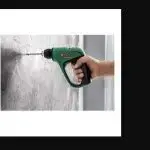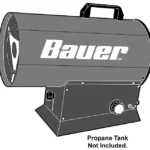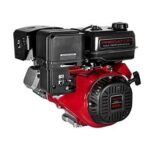
10/2/50 Amp 12 Volt Battery Charger/Starter
Owner’s Manual & Safety Instructions
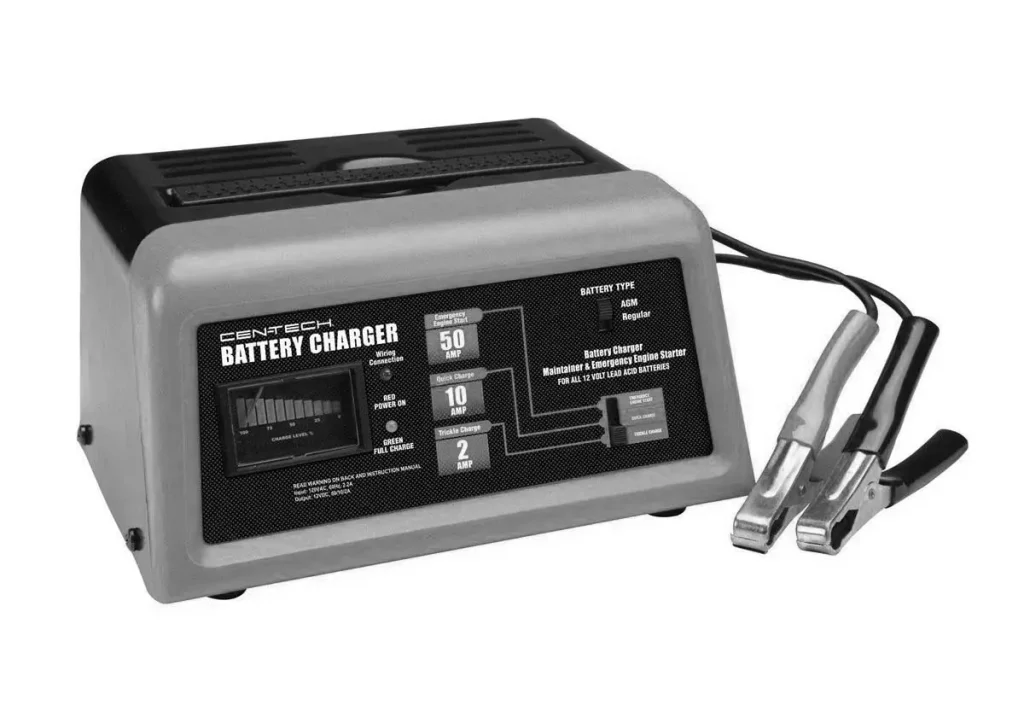
Save This Manual Keep this manual for the safety warnings and precautions, assembly, operating, inspection, maintenance and cleaning procedures. Write the product’s serial number in the back of the manual near the assembly diagram (or month and year of purchase if product has no number).
Keep this manual and the receipt in a safe and dry place for future reference.
Visit our website at: http://www.harborfreight.com
Email our technical support at: [email protected]
When unpacking, make sure that the product is intact and undamaged. If any parts are missing or broken, please call 1-888-866-5797 as soon as possible.
Copyright© 2012 by Harbor Freight Tools®. All rights reserved.
No portion of this manual or any artwork contained herein may be reproduced in any shape or form without the express written consent of Harbor Freight Tools.
Diagrams within this manual may not be drawn proportionally. Due to continuing improvements, actual product may differ slightly from the product described herein.
Tools required for assembly and service may not be included.
WARNINGS
Read this material before using this product.
Failure to do so can result in serious injury.
SAVE THIS MANUAL.
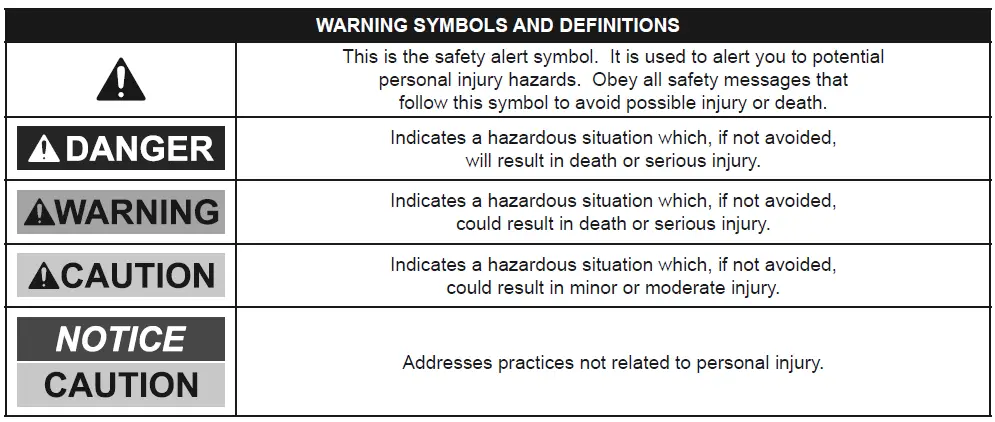

Important Safety Instructions
- SAVE THESE INSTRUCTIONS –
This manual contains important safety and operating instructions for this battery charger. - Do not expose charger to rain or snow.
- Use of an attachment not recommended or sold by the battery charger manufacturer may result in a risk of fire, electric shock, or injury to persons.
- To reduce risk of damage to electric plug and cord, pull by plug rather than cord when disconnecting charger.
- An extension cord should not be used unless absolutely necessary. Use of improper extension cord could result in a risk of fire and electric shock.
If an extension cord must be used, make sure:
a. That pins on plug of extension cord are the same number, size, and shape as those of plug on charger;
b. That extension cord is properly wired and in good electrical condition; and
c. That wire size is large enough for AC ampere rating of charger as specified in Table A. - Do not operate charger with damaged cord or plug – replace the cord or plug immediately.
- Do not operate charger if it has received a sharp blow, been dropped, or otherwise damaged in any way; take it to a qualified serviceman.
- Do not disassemble charger; take it to a qualified serviceman when service or repair is required. Incorrect reassembly may result in a risk of electric shock or fire.
- To reduce risk of electric shock, unplug charger from outlet before attempting any maintenance or cleaning. Turning off controls will not reduce this risk.
- WARNING – RISK OF EXPLOSIVE GASES.
a. WORKING IN VICINITY OF A LEAD-ACID BATTERY IS DANGEROUS. BATTERIES GENERATE EXPLOSIVE GASES DURING NORMAL BATTERY OPERATION. FOR THIS REASON, IT IS OF UTMOST IMPORTANCE THAT YOU FOLLOW THE INSTRUCTIONS EACH TIME YOU USE THE CHARGER.
b. To reduce risk of battery explosion, follow these instructions and those published by battery manufacturer and manufacturer of any equipment you intend to use in vicinity of battery. Review cautionary marking on these products and on engine. - PERSONAL PRECAUTIONS
a. Consider having someone close enough by to come to your aid when you work near a lead-acid battery.
b. Have plenty of fresh water and soap nearby in case battery acid contacts skin, clothing, or eyes.
c. Wear complete eye protection and clothing protection. Avoid touching eyes while working near battery.
d. If battery acid contacts skin or clothing, wash immediately with soap and water.
If acid enters eye, immediately flood eye with running cold water for at least 10 minutes and get medical attention immediately.
e. NEVER smoke or allow a spark or flame in vicinity of battery or engine.
f. Be extra cautious to reduce risk of dropping a metal tool onto battery. It might spark or short-circuit battery or other electrical part that may cause explosion.
g. Remove personal metal items such as rings, bracelets, necklaces, and watches when working with a lead-acid battery. A leadacid battery can produce a short-circuit current high enough to weld a ring or the like to metal, causing a severe burn.
h. Use charger for charging a LEAD-ACID battery only. It is not intended to supply power to low voltage electrical system other than in a starter-motor application. Do not use battery charger for charging dry-cell batteries that are commonly used with home appliances.
These batteries may burst and cause injury to persons and damage to property.
i. NEVER charge a frozen battery. - PREPARING TO CHARGE
a. If necessary to remove battery from vehicle to charge, always remove grounded terminal from battery first. Make sure all accessories in the vehicle are off, so as not to cause an arc.
b. Be sure area around battery is well ventilated while battery is being charged.
c. Clean battery terminals. Be careful to keep corrosion from coming in contact with eyes.
d. Add distilled water in each cell until battery acid reaches level specified by battery manufacturer. Do not overfill. For a battery without removable cell caps, such as valve regulated lead acid batteries, carefully follow manufacturer’s recharging instructions.
e. Study all battery manufacturer’s specific precautions while charging and recommended rates of charge.
f. Charge battery initially at lowest rate. - CHARGER LOCATION
a. Locate charger as far away from battery as DC cables permit.
b. Never place charger directly above battery being charged; gases from battery will corrode and damage charger.
c. Never allow battery acid to drip on charger when reading electrolyte specific gravity or filling battery.
d. Do not operate charger in a closed-in area or restrict ventilation in any way.
e. Do not set a battery on top of charger. - DC CONNECTION PRECAUTIONS
a. Connect and disconnect DC output clips only after removing AC cord from electric outlet.
Never allow clips to touch each other.
b. Attach clips to battery and chassis as indicated in 15(e), 15(f), and 16(b) through 16(d). - FOLLOW THESE STEPS WHEN BATTERY IS INSTALLED IN VEHICLE. A SPARK NEAR BATTERY MAY CAUSE BATTERY EXPLOSION.
TO REDUCE RISK OF A SPARK NEAR BATTERY:
a. Position AC and DC cables to reduce risk of damage by hood, door, or moving engine part.
b. Stay clear of fan blades, belts, pulleys, and other parts that can cause injury to persons.
c. Check polarity of battery posts. POSITIVE (POS, P, +) battery post usually has larger diameter than NEGATIVE (NEG, N,–) post.
d. Determine which post of battery is grounded (connected) to the chassis. If negative post is grounded to chassis (as in most vehicles), see (e). If positive post is grounded to the chassis, see (f).
e. For negative-grounded vehicle, connect POSITIVE (RED) clip from battery charger to POSITIVE (POS, P, +) ungrounded post of battery. Connect NEGATIVE (BLACK) clip to vehicle chassis or engine block away from battery. Do not connect clip to carburetor, fuel lines, or sheet-metal body parts. Connect to a heavy gauge metal part of the frame or engine block.
f. For positive-grounded vehicle, connect NEGATIVE (BLACK) clip from battery charger to NEGATIVE (NEG, N, –) ungrounded post of battery. Connect POSITIVE (RED) clip to vehicle chassis or engine block away from battery.
Do not connect clip to carburetor, fuel lines, or sheet-metal body parts. Connect to a heavy gauge metal part of the frame or engine block.
g. When disconnecting charger, disconnect AC cord, remove clip from vehicle chassis, and then remove clip from battery terminal.
h. See operating instructions for length of charge information. - FOLLOW THESE STEPS WHEN BATTERY IS OUTSIDE VEHICLE. A SPARK NEAR THE BATTERY MAY CAUSE BATTERY EXPLOSION.
TO REDUCE RISK OF A SPARK NEAR BATTERY:
a. Check polarity of battery posts. POSITIVE (POS, P, +) battery post usually has a larger diameter than NEGATIVE (NEG, N, –) post.
b. Attach at least a 24-inch-long 6-gauge (AWG) insulated battery cable to NEGATIVE (NEG, N, –) battery post.
c. Connect POSITIVE (RED) charger clip to POSITIVE (POS, P, +) post of battery.
d. Position yourself and free end of cable as far away from battery as possible – then connect NEGATIVE (BLACK) charger clip to free end of cable.
e. Do not face battery when making final connection.
f. When disconnecting charger, always do so in reverse sequence of connecting procedure and break first connection while as far away from battery as practical.
g. A marine (boat) battery must be removed and charged on shore. To charge it on board requires equipment specially designed for marine use. - Wear ANSI-approved splash-resistant safety goggles and heavy-duty rubber work gloves whenever connecting, disconnecting, or working near battery.
Battery acid can cause permanent blindness. - Do not use Start setting to charge batteries. Use to jump start only.
- Maintain labels and nameplates on the charger.
These carry important safety information.
If unreadable or missing, contact Harbor Freight Tools for a replacement. - This product is not a toy.
Keep it out of reach of children. - Unplug the Battery Charger from its electrical outlet before connecting its cables to a battery, or performing any inspection, maintenance, or cleaning procedures.
- Although this charger has an automatic cut off; do NOT depend solely on automatic cut off.
Leaving charger unattended can result in fire and property damage. - Use this charger with flooded lead-acid or AGM batteries only.
When charging a maintenance-free battery, always monitor the progress of the charge by viewing the Charge Meter.
Do not overcharge a maintenance-free battery.
DO NOT USE WITH GEL BATTERIES. - Do not attempt to charge non-rechargeable or defective batteries.
- Do not charge more than one battery at one time.
- Have your charger serviced by a qualified repair person using only identical replacement parts.
This will ensure that the safety of the charger is maintained. - Do not use charger while you are tired or under the influence of drugs, alcohol or medication.
A moment of inattention while operating charger may result in serious personal injury. - Before moving charger, disconnect power supply and battery, then allow charger to cool.
- People with pacemakers should consult their physician(s) before use. Electromagnetic fields in close proximity to heart pacemaker could cause pacemaker interference or pacemaker failure.
In addition, people with pacemakers should:
• Avoid operating alone.
• Properly maintain and inspect to avoid electrical shock.
• Properly ground power cord. Ground Fault Circuit
Interrupter (GFCI) should also be implemented
– it prevents sustained electrical shock. - The warnings, precautions, and instructions
discussed in this instruction manual cannot cover all possible conditions and situations that may occur. It must be understood by the operator that common sense and caution are factors which cannot be built into this product, but must be supplied by the operator.
SAVE THESE INSTRUCTIONS
Grounding and Ac power cord connection Instructions
Charger should be grounded to reduce risk of electric shock. Charger is equipped with an electric cord having an equipment-grounding conductor and a grounding plug. The plug must be plugged into an outlet that is properly installed and grounded in accordance with all local codes and ordinances.
DANGER – Never alter AC cord or plug provided – if it will not fit outlet, have proper outlet installed by a qualified electrician. Improper connection can result in a risk of an electric shock.
CAUTION – Risk of Fire or Electric Shock.
Connect battery charger directly to grounding receptacle (three-prong). An adapter should not be used with battery charger.
Specifications

*Amperage is only present when the unit is connected to a battery or in START mode.
Operation Instructions
Read the ENTIRE IMPORTANT SAFETY INFORMATION section at the beginning of this manual including all text under subheadings therein before set up or use of this product.
TO PREVENT SERIOUS INJURY:
DO NOT PLUG IN CHARGER UNTIL DIRECTED TO DO SO.
Controls
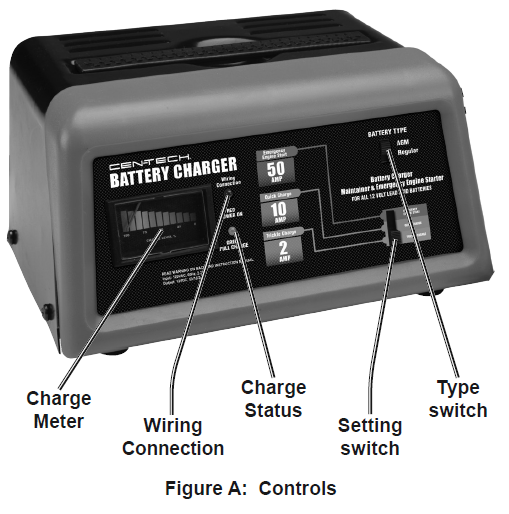
Wiring connection:
This indicates that the cables are connected improperly.
Immediately disconnect the cables and connect them properly to prevent damage to the battery.
Charge Status:
This will light up red when the power is connected.
This will light up green when the battery is fully charged.
This is disabled in start mode.
Setting switch:
Use this to switch between charging and start modes and change the output amperage.
Battery Type switch:
Use this to set the battery type:
- Set to Regular for flooded and maintenance-free batteries.
- Set to AGM for Absorbed Glass Mat batteries.
WARNING! TO PREVENT EXPLOSION:
DO NOT USE WITH GEL BATTERIES.
Charge Meter (10 amp charge mode only):
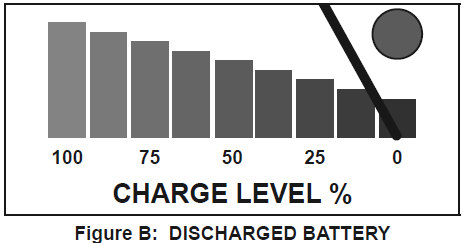
Initial charge current to the battery is at maximum.
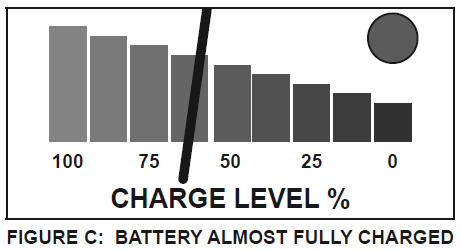
Charge current to the battery is reduced.
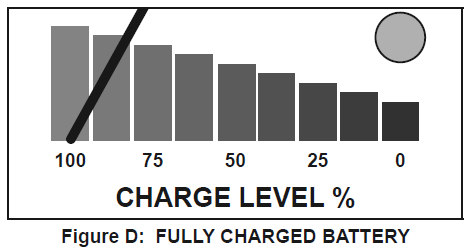
Charge current to the battery is minimal and the green LED is on.
Sometimes conditions such as a cold battery, a sulfated battery, or a deeply discharged lead calcium battery may cause Charge Meter to read near a full charge when charging process is only beginning.
Note: The Charge Meter shows the amount of current being drawn from the charger. It does not show what the charger is capable of delivering. When the battery is fully charged and registering 100% on the Charge Meter,
a small charge will continue to move from the charger to the battery. If the charger is not disconnected from the battery, eventually heat build up will cause the battery acid to boil and overcharge the battery causing damage to the battery. Monitor battery charging progress constantly and if battery gets warm, stop charging it immediately.
Preparing to Charge
WARNINGS:
Use this charger only on flooded lead-acid batteries.
Other batteries may be damaged or may overheat, leak, or catch fire.
TO PREVENT SERIOUS INJURY:
Wear ANSI-approved splash-resistant safety goggles and heavy-duty rubber work gloves whenever connecting, disconnecting, or working near battery.
Battery acid can cause permanent blindness.
- If necessary to remove battery from vehicle to charge, always remove grounded terminal from battery first. Make sure all accessories in the vehicle are off, so as not to cause an arc.
- Make sure area around battery is well ventilated while battery is being charged.
- Clean battery terminals. Be careful to keep corrosion from coming in contact with eyes.
- Add distilled water in each cell until battery acid reaches level specified by battery manufacturer.
Do not overfill. For a battery without removable cell caps, such as valve regulated lead acid batteries, carefully follow manufacturer’s recharging instructions. - Study all battery manufacturer’s specific precautions while charging and recommended rates of charge.
- Charge battery initially at lowest rate.
- A marine (boat) battery must be removed and charged on shore. To charge it on board requires equipment specially designed for marine use.
SHORTED BATTERIES – will read on Charge Meter as a high end peg at beginning of charging process. If after 5-10 minutes, needle does not move off high end, the battery probably has a short circuit. Unplug charger and discontinue use.
Have battery checked by a qualified technician.
COLD BATTERIES – begin charging at a low rate, increase as battery reaches a normal temperature, then rate will decrease normally.
DO NOT CHARGE A FROZEN BATTERY.
BATTERIES WITH HYDROMETER EYE:
Do not depend on hydrometer eye to determine battery charge level.
Charger Location
- Locate charger as far away from battery as DC cables permit.
- Never place charger directly above battery being charged; gases from battery will corrode and damage charger.
- Never allow battery acid to drip on charger when reading electrolyte specific gravity or filling battery.
- Do not operate charger in a closed-in area or restrict ventilation in any way.
- Do not set a battery on top of charger.
Charging Battery Installed in Vehicle
WARNINGS:
A spark near battery may cause battery explosion.
To reduce risk of a spark near battery follow these instructions exactly.
TO PREVENT SERIOUS INJURY:
Wear ANSI-approved splash-resistant safety goggles and heavy-duty rubber work gloves whenever connecting, disconnecting, or working near battery.
Battery acid can cause permanent blindness.
WARNING! Do not use Start setting to charge batteries. Use to jump start only.
- Position AC and DC cables to reduce risk of damage by hood, door, or moving engine part.
- Stay clear of fan blades, belts, pulleys, and other parts that can cause injury to persons.
- Check polarity of battery posts. POSITIVE (POS, P, +) battery post usually has larger diameter than NEGATIVE (NEG, N,–) post.
- Determine which post of battery is grounded (connected) to the chassis. If negative post is grounded to chassis (as in most vehicles), see 5.
If positive post is grounded to the chassis, see 6. - For negative-grounded vehicle, connect POSITIVE (RED) clip from battery charger to POSITIVE (POS, P, +) ungrounded post of battery.
Connect NEGATIVE (BLACK) clip to vehicle chassis or engine block away from battery.
Do not connect clip to carburetor, fuel lines, or sheet-metal body parts. Connect to a heavy gauge metal part of the frame or engine block.
NOTICE: If the Reverse connection indicator lights, the cables are connected improperly.
Immediately disconnect the cables and connect them properly to prevent damage to the battery. - For positive-grounded vehicle, connect NEGATIVE (BLACK) clip from battery charger to NEGATIVE (NEG, N, –) ungrounded post of battery. Connect POSITIVE (RED) clip to vehicle chassis or engine block away from battery.
Do not connect clip to carburetor, fuel lines, or sheet-metal body parts. Connect to a heavy gauge metal part of the frame or engine block.
Note: If the charger cycles between maximum charge level and a lower charge level when first connected, then the battery may be fully charged or nearly fully charged. Further charging may not be needed.
If charging is attempted, charge at a lower rate and carefully monitor charge level to avoid battery damage. - Set Battery Type switch according to battery type:
• Set to Regular for flooded and maintenance-free batteries.
• Set to AGM for Absorbed Glass Mat batteries.
WARNING! TO PREVENT EXPLOSION:
DO NOT USE WITH GEL BATTERIES. - Set Setting switch to 2A Trickle Charge or 10A Quick Charge.
WARNING! Do not use 50A Emergency Engine Start function for charging. - After switches are set, plug in charger.
- Monitor the charging process.
The Charge Complete indicator will light up and blink when the battery is fully charged. - When disconnecting charger, disconnect AC cord, remove clip from vehicle chassis, and then remove clip from battery terminal.
- After use clean, then store the charger indoors out of children’s reach.
Charging Battery Outside Vehicle
WARNINGS:
A spark near battery may cause battery explosion.
To reduce risk of a spark near battery follow these instructions exactly.
TO PREVENT SERIOUS INJURY:
Wear ANSI-approved splash-resistant safety goggles and heavy-duty rubber work gloves whenever connecting, disconnecting, or working near battery.
Battery acid can cause permanent blindness.
WARNING! Do not use Start setting to charge batteries. Use to jump start only.
- Check polarity of battery posts. POSITIVE (POS, P, +) battery post usually has a larger diameter than NEGATIVE (NEG, N, –) post.
- Attach at least a 24-inch-long 6-gauge (AWG) insulated battery cable to NEGATIVE (NEG, N, –) battery post.
- Connect POSITIVE (RED) charger clip to POSITIVE (POS, P, +) post of battery.
- Position yourself and free end of cable as far away from battery as possible – then connect NEGATIVE (BLACK) charger clip to free end of cable.
- Do not face battery when making final connection.
NOTICE: If the Reverse connection indicator lights, the cables are connected improperly.
Immediately disconnect the cables and connect them properly to prevent damage to the battery. - Set Battery Type switch according to battery type:
• Set to Regular for flooded and maintenance-free batteries.
• Set to AGM for Absorbed Glass Mat batteries.
WARNING! TO PREVENT EXPLOSION:
DO NOT USE WITH GEL BATTERIES. - Set Setting switch to 2A Trickle Charge or 10A Quick Charge.
WARNING! Do not use 50A Emergency Engine Start function for charging. - After switches are set, plug in charger.
- Monitor the charging process.
The Charge Complete indicator will light up and blink when the battery is fully charged. - When disconnecting charger, always do so in reverse sequence of connecting procedure and break first connection while as far away from battery as practical.
- After use clean, then store the charger indoors out of children’s reach.
12V Engine Starting
NOTICE: Some vehicles with onboard computers may be damaged from the high-current starting output.
Thoroughly read the vehicle service manual before using this procedure.
WARNING! Do not use Start setting to charge batteries. Use to jump start only.
Note: During extremely cold weather or when battery is severely exhausted, charge the battery for about five minutes before attempting to turn on engine.
1. Unplug the Charger AC power cord from the AC outlet.
2. For negative-grounded vehicle, connect POSITIVE (RED) clip from battery charger to POSITIVE (POS, P, +) ungrounded post of battery.
Connect NEGATIVE (BLACK) clip to vehicle chassis or engine block away from battery.
Do not connect clip to carburetor, fuel lines, or sheet-metal body parts. Connect to a heavy gauge metal part of the frame or engine block.
NOTICE: If the Reverse connection indicator lights, the cables are connected improperly.
Immediately disconnect the cables and connect them properly to prevent damage to the battery.
3. Position AC and DC cables to reduce risk of damage by hood, door, or moving engine part.
4. Set Battery Type switch according to battery type:
• Set to Regular for flooded and maintenance-free batteries.
• Set to AGM for Absorbed Glass Mat batteries.
WARNING! TO PREVENT EXPLOSION:
DO NOT USE WITH GEL BATTERIES.
5. Set Setting switch to 50A Emergency Engine Start.
6. After switches are set, plug in charger.
7. WARNING! TO PREVENT SERIOUS
INJURY, FIRE, AND DAMAGE TO
CHARGER AND BATTERY, follow 5 second maximum with 4 minute minimum rest
duty cycle for the Start mode.
8. To start the engine, turn ignition key.
ONLY KEEP CHARGER IN START MODE UP TO 5 SECONDS AT A TIME.
9. If engine fails to start, charge battery for an additional five minutes before attempting to start.
10. After the engine starts, unplug the power cord from outlet before disconnecting the DC cable clamps.
Maintenance Instructions
Procedures not specifically explained in this manual must be performed only by a qualified technician.
WARNINGS:
TO PREVENT SERIOUS INJURY: Unplug the charger, disconnect any battery, and allow charger to cool completely before performing any inspection, maintenance, or cleaning procedures.
TO PREVENT SERIOUS INJURY FROM CHARGER FAILURE:
Do not use damaged equipment. If abnormal noise or vibration occurs, have the problem corrected before further use.
1. BEFORE EACH USE, inspect the general condition of the charger. Check for:
- loose hardware,
- cracked or broken parts,
- damaged electrical wiring or cable insulation, and
- any other condition that may affect its safe operation.
2. AFTER USE, wipe external surfaces of the charger with clean cloth.
3. WARNING! If the supply cord of this charger is damaged, it must be replaced only by a qualified service technician.
DO NOT OPEN CHARGER HOUSING, NO USER-SERVICEABLE PARTS INSIDE.
Troubleshooting
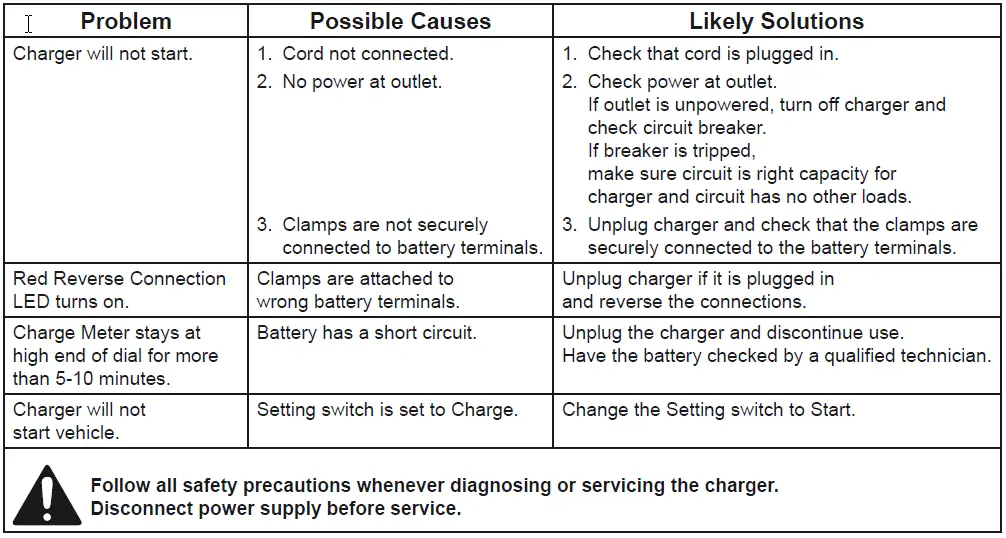
Record product’s Serial Number Here:___________________________________
Note: If product has no serial number, record month and year of purchase instead.
Note: Internal parts are not user-serviceable. Replacement parts are not available.
Limited 90 Day Warranty
Harbor Freight Tools Co. makes every effort to assure that its products meet high quality and durability standards, and warrants to the original purchaser that this product is free from defects in materials and workmanship for the period of 90 days from the date of purchase. This warranty does not apply to damage due directly or indirectly, to misuse, abuse, negligence or accidents, repairs or alterations outside our facilities, criminal activity, improper installation, normal wear and tear, or to lack of maintenance. We shall in no event be liable for death, injuries to persons or property, or for incidental, contingent, special or consequential damages arising from the use of our product. Some states do not allow the exclusion or limitation of incidental or consequential damages, so the above limitation of exclusion may not apply to you. THIS WARRANTY IS EXPRESSLY IN LIEU OF ALL OTHER WARRANTIES, EXPRESS OR IMPLIED, INCLUDING THE WARRANTIES OF MERCHANTABILITY AND FITNESS.
To take advantage of this warranty, the product or part must be returned to us with transportation charges prepaid. Proof of purchase date and an explanation of the complaint must accompany the merchandise.
If our inspection verifies the defect, we will either repair or replace the product at our election or we may elect to refund the purchase price if we cannot readily and quickly provide you with a replacement. We will return repaired products at our expense, but if we determine there is no defect, or that the defect resulted from causes not within the scope of our warranty, then you must bear the cost of returning the product.
This warranty gives you specific legal rights and you may also have other rights which vary from state to state.
